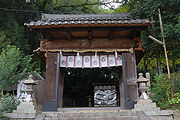
Honda Yasutoshi
Encyclopedia

was a Japanese samurai
Samurai
is the term for the military nobility of pre-industrial Japan. According to translator William Scott Wilson: "In Chinese, the character 侍 was originally a verb meaning to wait upon or accompany a person in the upper ranks of society, and this is also true of the original term in Japanese, saburau...
of the Azuchi-Momoyama Period
Azuchi-Momoyama period
The came at the end of the Warring States Period in Japan, when the political unification that preceded the establishment of the Tokugawa shogunate took place. It spans the years from approximately 1573 to 1603, during which time Oda Nobunaga and his successor, Toyotomi Hideyoshi, imposed order...
through early Edo period
Edo period
The , or , is a division of Japanese history which was ruled by the shoguns of the Tokugawa family, running from 1603 to 1868. The political entity of this period was the Tokugawa shogunate....
, who served the Tokugawa clan
Tokugawa clan
The was a powerful daimyo family of Japan. They nominally descended from Emperor Seiwa and were a branch of the Minamoto clan by the Nitta clan. However, the early history of this clan remains a mystery.-History:...
; he later became a daimyo
Daimyo
is a generic term referring to the powerful territorial lords in pre-modern Japan who ruled most of the country from their vast, hereditary land holdings...
. Yasutoshi was the second son of Sakai Tadatsugu
Sakai Tadatsugu
was one of the most favored and most and successful military commanders serving Tokugawa Ieyasu in the late-Sengoku period. He is regarded as one of the Four Guardians of the Tokugawa .along with Honda Tadakatsu, Ii Naomasa, and Sakakibara Yasumasa.-Sakai clan genealogy:The Sakai clan originated in...
; after a time as a hostage to the Oda clan
Oda clan
The was a family of Japanese daimyo who were to become an important political force in the unification of Japan in the mid-16th century. Though they had the climax of their fame under Oda Nobunaga and fell from the spotlight soon after, several branches of the family would continue on as daimyo...
; he was adopted by Honda Tadatsugu
Honda Tadatsugu
Honda Tadatsugu was a Japanese samurai of the Azuchi-Momoyama period, who served the Tokugawa clan....
in 1580. Upon Tokugawa Ieyasu
Tokugawa Ieyasu
was the founder and first shogun of the Tokugawa shogunate of Japan , which ruled from the Battle of Sekigahara in 1600 until the Meiji Restoration in 1868. Ieyasu seized power in 1600, received appointment as shogun in 1603, abdicated from office in 1605, but...
's move to the Kantō region
Kanto region
The is a geographical area of Honshu, the largest island of Japan. The region includes the Greater Tokyo Area and encompasses seven prefectures: Gunma, Tochigi, Ibaraki, Saitama, Tokyo, Chiba, and Kanagawa. Within its boundaries, slightly more than 40 percent of the land area is the Kantō Plain....
in 1590, Yasutoshi was granted 5,000 koku
Koku
The is a Japanese unit of volume, equal to ten cubic shaku. In this definition, 3.5937 koku equal one cubic metre, i.e. 1 koku is approximately 278.3 litres. The koku was originally defined as a quantity of rice, historically defined as enough rice to feed one person for one year...
of land in Shimōsa Province.
Yasutoshi served at the Battle of Sekigahara
Battle of Sekigahara
The , popularly known as the , was a decisive battle on October 21, 1600 which cleared the path to the Shogunate for Tokugawa Ieyasu...
in 1600, for his service there, he was awarded with lordship of the Nishio Domain
Nishio Domain
was a Japanese domain of the Edo period, located in former Mikawa Province, in what is now the modern-day city of Nishio in Aichi Prefecture, Japan. It was centered on Nishio Castle.-History:...
of Mikawa
Mikawa Province
is an old province in the area that today forms the eastern half of Aichi Prefecture. It was sometimes called . Mikawa bordered on Owari, Mino, Shinano, and Tōtōmi Provinces....
(20,000 koku
Koku
The is a Japanese unit of volume, equal to ten cubic shaku. In this definition, 3.5937 koku equal one cubic metre, i.e. 1 koku is approximately 278.3 litres. The koku was originally defined as a quantity of rice, historically defined as enough rice to feed one person for one year...
). During the Siege of Osaka
Siege of Osaka
The was a series of battles undertaken by the Tokugawa shogunate against the Toyotomi clan, and ending in that clan's destruction. Divided into two stages , and lasting from 1614 to 1615, the siege put an end to the last major armed opposition to the shogunate's establishment...
in 1614, he defended Zeze Castle, and during the battls in the following year, took part in the actual fighting, reportedly taking over 105 heads. As a reward for his service at Osaka, he was moved to the Zeze Domain
Zeze Domain
The was a feudal domain in Japan during the Edo period. It was established by Tokugawa Ieyasu as a reward to Toda Kazuaki, whom he transferred from a 5,000 koku territory in Musashi Province to this 30,000 koku domain in Ōmi Province. The domain government had its headquarters at Zeze Castle in...
, and his stipend was increased to 30,000 koku
Koku
The is a Japanese unit of volume, equal to ten cubic shaku. In this definition, 3.5937 koku equal one cubic metre, i.e. 1 koku is approximately 278.3 litres. The koku was originally defined as a quantity of rice, historically defined as enough rice to feed one person for one year...
.
Yasutoshi died in early 1621 at the age of 53.

